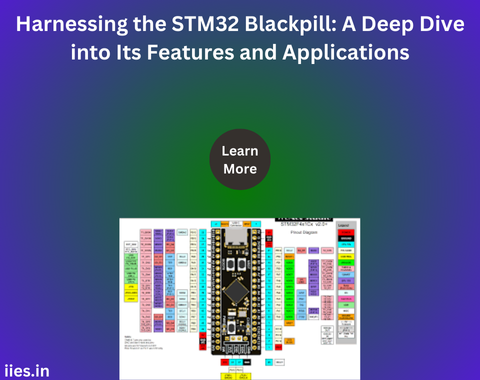
The STM32 Blackpill is a compact and powerful development board that has gained popularity among electronics enthusiasts and professionals alike. It is part of the STM32 family of microcontrollers, which are based on ARM Cortex-M cores. The STM32 Blackpill, in particular, is known for its small form factor, affordability, and versatility, making it an excellent choice for a wide range of embedded systems projects.
Microcontroller Core: At the heart of the STM32 Blackpill is an STM32 microcontroller, typically from the F4 or F1 series. These microcontrollers are based on ARM Cortex-M4 or Cortex-M3 cores, offering a balance of performance and power efficiency. The STM32F411CEU6, for instance, is a common variant used in Blackpill boards, providing a clock speed of up to 100 MHz and a rich set of peripherals.
Form Factor and Size: The Blackpill’s compact size is one of its most appealing features. Measuring just about 53mm x 22mm, it is small enough to be easily integrated into projects where space is a premium. Despite its small footprint, the board includes a large number of GPIO pins, making it highly adaptable to various applications.
Memory and Storage: The STM32 Blackpill boards generally come with 512 KB of Flash memory and 128 KB of SRAM. This memory configuration is sufficient for most embedded applications, allowing for the storage of code and data with room to spare. The board also supports external memory interfaces if additional storage is required.
Peripheral Interfaces: The Blackpill is equipped with a wide range of peripheral interfaces, including I2C, SPI, UART, and USB. This makes it easy to connect the board to a variety of sensors, actuators, and other external devices. Additionally, the presence of a USB OTG (On-The-Go) interface allows the Blackpill to act as a USB host or device, further expanding its versatility.
Power Supply Options: The STM32 Blackpill can be powered through multiple methods, including USB, an external power supply, or even a battery. This flexibility in power options makes it suitable for both portable and stationary applications. The board’s power consumption is also relatively low, which is crucial for battery-operated projects.
Development Environment: One of the strengths of the STM32 ecosystem is the robust development environment it offers. The STM32 Blackpill is fully supported by the STM32CubeIDE, a comprehensive development platform that includes an integrated development environment (IDE), a graphical configuration tool, and a comprehensive set of software libraries. This makes it easier for developers to get started and reduces the learning curve associated with embedded systems programming.
Community and Support: The STM32 Blackpill benefits from a large and active community. This community-driven support is invaluable for both beginners and advanced users, providing access to a wealth of tutorials, libraries, and project examples. The availability of community resources accelerates the development process and helps troubleshoot issues that may arise during the design and implementation phases.
The STM32 Blackpill is versatile enough to be used in a variety of applications, ranging from simple projects like LED control and sensor interfacing to more complex systems such as drones, robotics, and IoT devices. Its powerful microcontroller, extensive peripheral support, and small size make it ideal for projects that require both performance and compactness.
In the world of Internet of Things (IoT), the Blackpill can serve as a node in a larger network, gathering data from sensors and communicating with other devices over Wi-Fi or Bluetooth (with the addition of external modules). Its low power consumption is also a significant advantage in these applications, where energy efficiency is often a key consideration.
The STM32 Blackpill stands out as a powerful, flexible, and cost-effective development board within the STM32 family. Its combination of small size, robust features, and strong community support makes it an excellent choice for a wide range of embedded systems projects. Whether you are a hobbyist looking to experiment with new ideas or a professional engineer designing a complex system, the STM32 Blackpill offers the tools and capabilities to bring your project to life.
Indian Institute of Embedded Systems – IIES